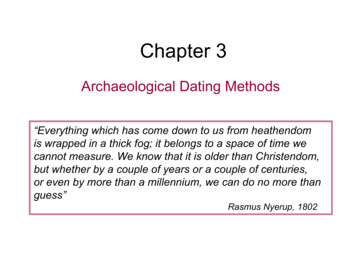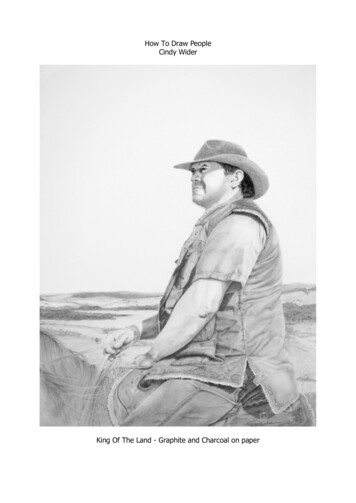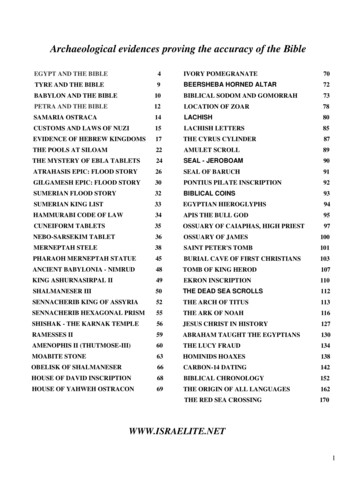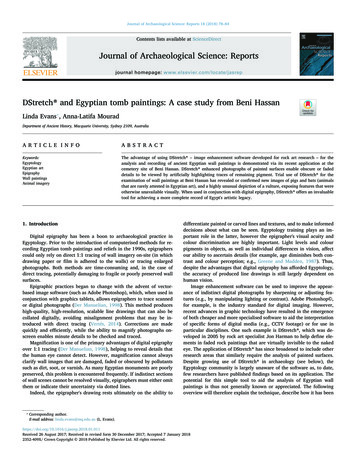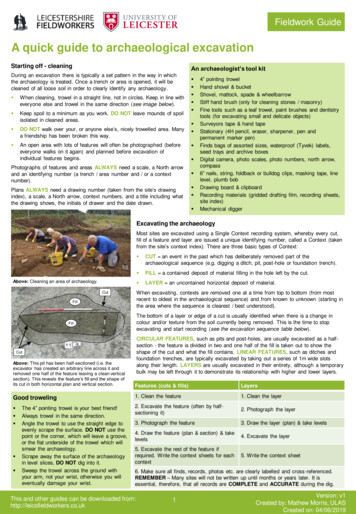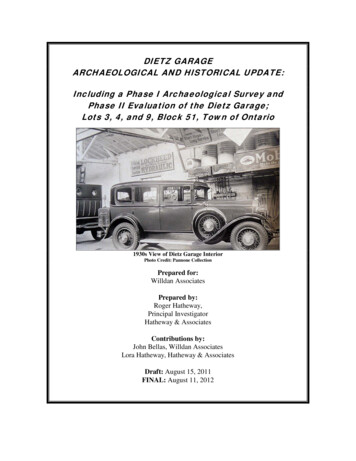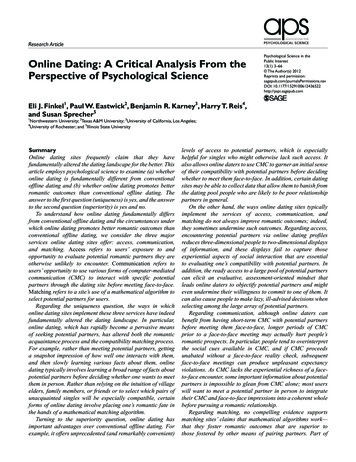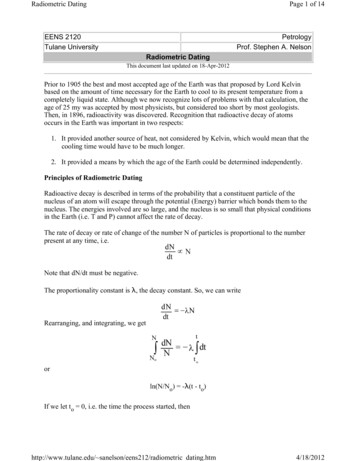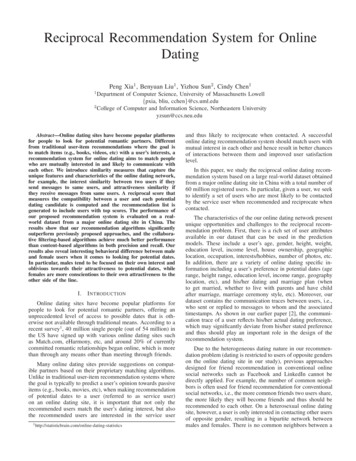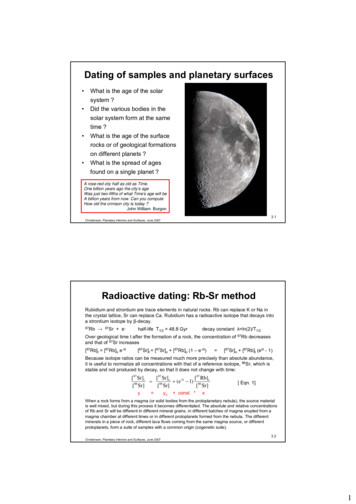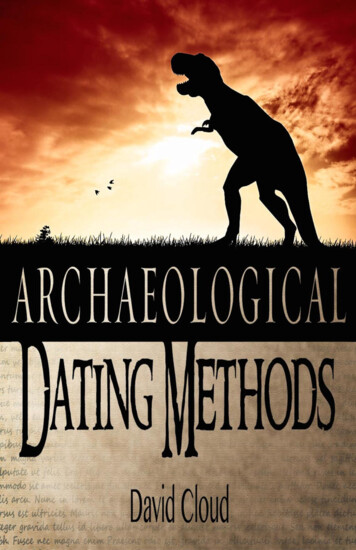
Transcription
i
Archaeological Dating MethodsCopyright 2014 by David W. CloudThis edition June 27, 2014ISBN 1-58318-177-5This book is published for free distribution in eBook format.It is available in PDF, Mobi (for Kindle, etc.) and ePubformats from the Way of Life web site. See the Free eBooktab at www.wayoflife.org. We do not allow distribution of ourfree books from other web sites.Published by Way of Life LiteraturePO Box 610368, Port Huron, MI 48061866-295-4143 (toll free) - fbns@wayoflife.orgwww.wayoflife.orgCanada: Bethel Baptist Church4212 Campbell St. N., London Ont. N6P 1A6519-652-2619Printed in Canada byBethel Baptist Print Ministryii
Table of ContentsArchaeological Dating Methods.1We Refuse Dates That Contradict the Bible .3Carbon-14 Dating .10About Way of Life’s eBooks .19Powerful Publications for These Times.20iii
Archaeological Dating MethodsArchaeology is typically built upon the evolutionaryassumption that man evolved from a stone age (lasting about3.4 million years) to a bronze age (c. 3000-1200 BC) to aniron age, each evolutionary ascent being accompanied bychanges in culture and religion.The bronze age is said to have begun about 3000 BC, whichis about the time of Noah’s birth by the biblical timeline.Thus, according to evolution, Noah and his generation wouldbarely have crawled out of the cave to exchange their stoneclubs for bronze ones!Frederic Kenyon attributed the features of the JordanValley to vast terrestrial movements two million years ago,and William Albright claimed that “Homo sapiens” evolvedartistic abilities sometime around 30,000 to 20,000 B.C.As we saw in the Introduction to this book, even“evangelicals” commit this heresy. Consider the followingstatements by Alfred Hoerth, former director of archaeologyat Wheaton College, in a book published by the “evangelical”Baker Books:“Fossils and mastodons date to prehistoric times. . Theterm neolithic is used to designate a period beginningwith the domestication of plants and animals andending with the introduction of metals . The Neolithicperiod was a time of profound change in human societyas the focus changed from hunting and gathering todomestication and farming. . there were no metal toolsin Neolithic times” (Archaeology and the Old Testament,Grand Rapids: Baker Academic, 1998, pp. 15, 36, 38,82).Actually, there were no “prehistoric” times and no timeswhen man did not use metal, including complex alloy metals.This is a mythical concept. The Bible plainly states thatAdam’s immediate children knew how to domesticate plants1
and animals and work with brass and iron (Gen. 4:20-22),and there is no solid evidence that disproves this.In fact, there is archaeological evidence of ironinstruments dating to more than 1,500 years before thesupposed iron and bronze age, but this evidence is typicallyignored or downplayed in favor of the evolutionary scheme.“At a site in Mesopotamia about fifty miles northeast ofBaghdad, called Tell Asmar today, but known in ancienttimes as Eshnuna, Henri Frankfort of the OrientalInstitute at the University of Chicago found evidence ofan iron blade from the level of 2700 B.C. A small steel axfrom Ur and other very early objects of iron have alsobeen found. The fact that a greater abundance of ironhas not been found seems to indicate that it was notwidely used in early times, but another contributingfactor may be that iron oxidizes more quickly andcompletely than copper and, having disintegrated,would not be as readily detected in excavating.Numerous archaeological discoveries give evidence ofthe use of copper during the period 4300-3000” (JosephFree, Archaeology and Bible History, p. 37).The major supposed evidence that archaeologists use todiscredit the Bible (other than the argument from silence) istheir dating system, which often is contrary to the biblicaldates.2
We Refuse Dates That Contradict theBibleFor the following important reasons we refuse to acceptarchaeological dates that contradict the Bible:First, the Bible has demonstrated its accuracy in the faceof the most vicious assaults, whereas the skeptics have beenproven wrong consistently.Consider that in the 19th century, skeptics claimed thatwriting didn’t exist in Moses’ day. They doubted the existenceof Ur of the Chaldees, of the advanced ancient city-states andreligious towers mentioned in Genesis 10-11, of complexlegal codes in that era, of camels in Palestine in the days ofAbraham, of King David and King Solomon, of the Hittitesand the Philistines, of Sargon and Nebuchadnezzar andBelshazzar, to name a few. They said that the book of Actswas filled with historical inaccuracies.In all of these cases and hundreds more, the skeptics werewrong and the Bible was right.Second, the authority of the Bible is settled upon thetestimony of Jesus Christ.Jesus claimed to be the Son of God, and His resurrectionalone gives infallible witness to this claim. The evidence forChrist’s resurrection is irrefutable, as we have shown in thisbook. Consider just four of these evidences: First, there is theamazing candor of the Gospel accounts. When someoneinvents a religion, he glorifies its leaders, but the four Gospelspaint the founders of Christianity as very weak (e.g., Peterdenying Christ thrice; the disciples fleeing and hiding;Thomas and others doubting Christ even after He appearedto them). Further, if men had made up the accounts ofChrist’s resurrection in the Gospels, they would not have said3
that the women were the first to believe. In that day womenhad no authority in the eyes of society. The account of thewomen believing first is not something that would have beenwritten unless it actually happened and unless the writerswere committed to recording the truth, the whole truth, andnothing but the truth. This striking candor is powerfulevidence that the Gospels are true, unvarnished accounts.Second, the resurrected Christ was seen by hundreds of eyewitnesses, most of whom were still alive when Paulinterviewed them a couple of decades later and wrote about itin the first epistle to the Corinthians (1 Cor. 15:1-8). Third,the resurrection dramatically changed Christ’s disciples.Before the resurrection they were fearful and in hiding,whereas after they saw and touched Him they became boldand were willing to suffer and die for their faith. Fourth, theenemies of Christ have never produced His body; the tombremains empty to this day. As George Hanson rightly says,“The simple faith of the Christian who believes in theresurrection is nothing compared to the credulity of theskeptic who will accept the wildest and most improbableromances rather than admit the plain witness of historicalcertainties. The difficulties of belief may be great; theabsurdities of unbelief are greater” (The Resurrection and theLife).Christ taught that the Bible is the infallible Word of God.He quoted from every part of the Old Testament as the Wordof God. Some of the Old Testament people and events thatChrist referred to are the creation (Mk. 13:19), Adam and Eve(Mat. 19:4-6; Mk. 10:6-7), Cain and Abel (Mat. 23:35; Lk.11:50-51), Noah and the flood (Mat. 24:37-39), Abraham (Jn.8:39-40), the destruction of Sodom and Gomorrah (Lk.17:28-29), Lot’s wife turning to salt (Lk. 17:32), Moses andthe burning bush (Mk. 12:26), manna from heaven (Jn.6:31-32), the brazen serpent in the wilderness (Jn. 3:14-15),Jonah and the whale (Mat. 12:39-41; Lk. 11:29-32), Ninevehrepenting at Jonah’s preaching (Lk. 11:32), Solomon and the4
queen of Sheba (Lk. 11:31). Christ often quoted from thebook Isaiah and said the historical prophet Isaiah wrote it,not an unknown group of men as the critics claim. In John12:38-41, Jesus quoted from both major sections of Isaiahand said both were written by the same prophet namedIsaiah.Of the authority of the Old Testament, Jesus said,“Think not that I am come to destroy the law, or theprophets: I am not come to destroy, but to fulfil. Forverily I say unto you, Till heaven and earth pass, one jotor one tittle shall in no wise pass from the law, till all befulfilled” (Mat. 5:17-18).In this passage Jesus taught that the Old Testament isperfect even to the very letters.He further said that “the scripture cannot be broken” (John10:35). He was saying that nothing written in the Scripturecan be set aside or ignored. It is authoritative to every detail;it is a chain with no weak links.On Christ’s authority alone we would trust the Bible andreject the skeptics.Third, archaeological dates are uncertain by theadmission of archaeologists themselves.The renowned archaeologist Leonard Woolley, excavator ofthe ancient city of Ur, said:“Archaeological excavation provides us with a relativesequence . but it does not of itself offer an absolutechronology in years . Even when written recordsprovide information upon which such an absolutechronology can be constructed, THE FURTHER THISGOES BACK IN TIME THE GREATER GROWS THEPOSSIBLE MARGIN OF ERROR. ANY SYSTEM WEADOPT STILL HAS TO BE REGARDED ASTENTATIVE AND LIABLE TO REVISION, POSSIBLYMAJOR ONES BEFORE THE MIDDLE OF THE5
SECOND MILLENNIUM B.C.” (Ur of the Chaldees,revised by P.R.S. Moorey, p. 16).In his biography of King Hammurabi of Babylon, MarcVan De Mieroop admits that the dates he gives forHammurabi’s reign (1792-1750 B.C.) are not certain andadds, “The chronology of early Mesopotamian history andhow it relates to the Common Era is not fully clear.”In fact, dates for Hammurabi’s life differ more than 150years among archaeologists, having been variously dated to1848-1806 (long chronology), 1792-1750 (middlechronology), 1728-1686 (short chronology), and 1696-1654(ultra-short chronology) (Paul Kriwaczek, Babylon:Mesopotamia and the Birth of Civilization, 2012, Kindlelocation 173).Referring to the Hittite kingdom, we are told that theresources for determining dates are “inaccurate andunreliable” and the reconstruction of the sequence of Hittitekings is “still mostly educated guesswork” (Billie Jean Collins,The Hittites and Their World, p. 19). .The Tartaria Tablet, which was discovered in Bulgaria in1961, has been dated to 2,500 BC by conventional methodssuch as pottery and to as old as 5,500 BC by radiocarbonmethods. This is a variance of 3,000 years!We are told that “modern scholars” have competingtheories as to the date of Abraham, ranging from 2,200 to1,000 BC (Fant and Reddish, Lost Treasures of the Bible, p.33). That is a variation of more than 1,000 years!To accept such a fallible system as an authority equal tothat of the Bible and to allow it to overthrow the Bible wouldbe the height of foolishness, in our estimation.Fourth, archaeological dating methods are based onevolutionary assumptions.When archaeologists investigate the site of an ancient townor city, they dig a trench and often find layers of civilization6
built one on top of the other. They apply their evolutionaryassumptions to this and are convinced that they are lookingat the advance of civilization from a “stone age.”Actually, while there are stone age people, there is no stoneage. Men have lived in a wide variety of manners since thedays of Adam. Most of the North American Indians in theearly 19th century were “stone age” people who did not workwith metal, but they lived alongside the technologicallyadvanced Americans.Societies have lost and gained knowledge of technologythroughout history. After the Flood, Noah’s sons moved inmany directions and occupied various parts of the world, andwhile some of them were highly advanced, such as those inUr which we describe in these studies (e.g., highly literate,advanced metal working and agricultural techniques, farflung shipping enterprises, complex musical instruments,dazzling jewelry), others were content to live simple pastoralor hunting lifestyles and some of these eventually lost theknowledge of such things as metal working and writing.Consider the fact that the royalty and wealthy among theMinoans on the island of Crete (1700-1400 BC) had flushingtoilets with wooden seats and an overhead reservoir, but thistechnology was seemingly lost for a thousand years until redeveloped in the 3rd century AD in Rome.Archaeologists typically ignore evidence that doesn’t fittheir preconceived evolutionary theories. Consider thehistory of writing. The evolutionary model has writingevolving from crude pictures to complex alphabetic symbols,but consider the following facts from archaeology itself. First,the writing that is considered the oldest in existence does notfeature pictures but rather a script. This is the aforementionedTartaria Tablet. Second, one of the oldest known writingsystems, Egyptian, used a pictograph script and a nonpictograph script at the same time from the very beginning.Egyptian hieroglyphic (a pictograph script) and hieratic (analphabetic script) can be traced to the same general time in7
the third millennium BC. The hieratic did not arise from thehieroglyphic; rather, they had two different purposes. Thehieroglyphic was used, for the most part, for permanentinscriptions on stone and rock, while the hieratic was writtenby pen and ink on paper for everyday use.Fifth, archaeological dating methods are based oninexact methodology.Consider “CERAMIC TYPOLOGY.” Since the late 1800s,pottery has been viewed as one of the most trusted means ofdating ancient sites. This is called “ceramic typology.” In 1890,Flinders Petrie observed that each layer at Tel Hesi containedits own unique type of pottery. The method is based on thehypothesis that types of pottery changed with time and thatthe prevalence of a certain type of pottery in a certainarchaeological strata indicate a unique time period. Themethod was further developed by William Albright in the1920s and 1930s at Tel Beit Mirsim in southern Palestine.“His work remains the basis of all modern ceramic typology,wh
27.06.2014 · their dating system, which o"en is contrary to the biblical dates. 2. We Refuse Dates That Contradict the Bible For the following important reasons we refuse to accept archaeological dates that contradict the Bible: First, the Bible has demonstrated its accuracy in the face of the most vicious assaults, whereas the skeptics have been proven wrong consistently. Consider that in the 19th century .
